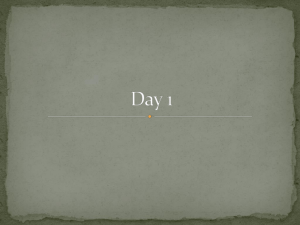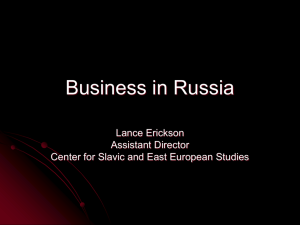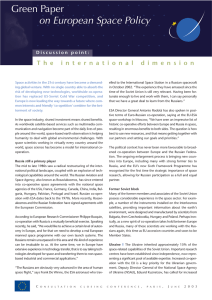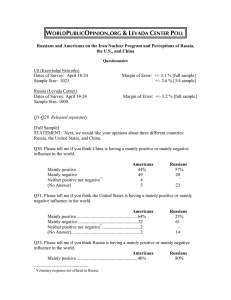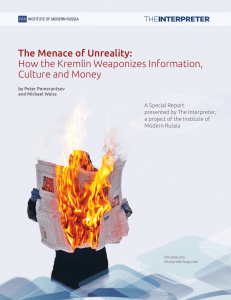Russia
advertisement
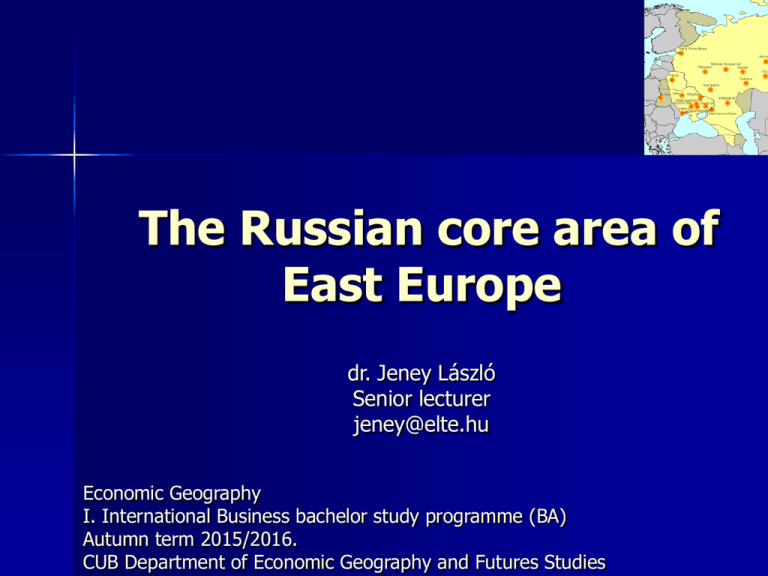
The Russian core area of East Europe dr. Jeney László Senior lecturer jeney@elte.hu Economic Geography I. International Business bachelor study programme (BA) Autumn term 2015/2016. CUB Department of Economic Geography and Futures Studies 1990s: economic hardship Transition to capitalism: economies shrank – Inefficient, uncompetitive factories – Most industries downsized dramatically shutting down 1998 global financial crisis – Depreciated the Russian ruble – Further lowered 2 living standards 2000s: economies began growing again Average 6–8 % GDP growth Russia – GDP: WR10. – Bureaucratic reforms – Soaring global prices for oil and natural gas – However: dependence on oil and gas (80% of exports, 32% of GDP in 2007 13% in 1999) 3 Foreign direct investments 1990s: inflow was prevented – Corruption – Poor infrastructure – Unwieldy bureaucracy RU 1991–2001 – FDI: 18,2 bn $ (China: 46 bn $) – Per capita FDI: 15 $ (1149 USA, 224 Hungary) After mid 2000s: FDI in Russia expanded rapidly – 2008: 70 bn – Investors: CY, NL, L, UK Sectors – Mainly oil, natural gas, metal ores – Also automotive industry (VW Kaluga, Ford and Japanese companies) 2006: first time foreign cars outsold domestic 4 cars Ethnic based conflicts and their geoeconomic impacts 5 Russia: mixture of political units 52 % of the minorities: autonomous territorial units: – 15 national autonomous republics – 2 autonomous districts (okrug) Homelands in European Russia – North Europe, Urals and Middle Volga: relative higher share of Russians – North Caucasus: Russian minority 90 numerically significant recognized nationalities – 55 nationalities without republic status (homeland) 6 Official constitutional position of republics 1990s: the Kremlin gave up much of its power – Also other official language besides Russian – 1350 newspapers, 300 TV and 250 radio channels in 50 minority languages and also in the federal TV and radio broadcasting – 75 minority languages taught in 10 thousand schools – Minority organisations (2000) 2000s: the Kremlin took it back – – – – – European Council: discrimination in legislation Public actions are hampered Lots of minorities are out of minority education Lack of minority teachers, books Maintenance of minority culture is insufficient 7 Area of Russian influences Periods of Russification 1) Early 1800s 2) Soviet times Permanent movements within the SU – Out-migration of Russians to Belarus and Ukraine till 1989 to industrial concentrations Share of ethnic Russians – Belarus: 13% (63% speaks regularly Russian) – Ukraine: 22% Crimean Peninsula, industrial areas of Eastern Ukraine, cities – Russia: 82% (re-migration) 8 Ethnic based tensions in the successor states North Caucasus: remained part of Russia resistance against Russian rule – 1991: Chechnya also attempted its independence 2 bloody wars in Russia (1994–1996 and after 1999 more 100 thousand victims) Ukraine: Crimean Peninsula and East Ukraine (Russians) – Crimean Peninsula and East Ukraine (Russians) Moldova: Transdnistria (Russians) Georgia: conflict with Russia – – – – Abkhazia (Abkhasians): occupied by Russia (hard entrance from Georgia) South Ossetia (Ossetians) Closed Georgian–Russian border Good relationship to the West (EU and NATO) Armenia: conflict with Turkey and Azerbaijan – – – – – Armenian genocide by Turkey (not declared by Turk.) Lost territories (Mt. Ararat) in Turkey Karabakh question: Nagorno-Karabakh (Armenians) in Azerbaijan Closed Arm–Turk and Arm–Azeri borders Good relationship with Russia 10





